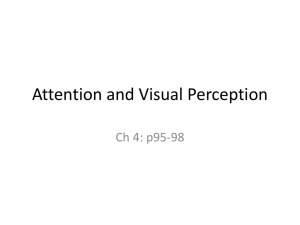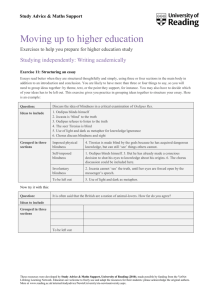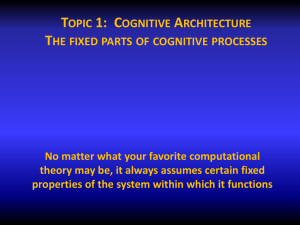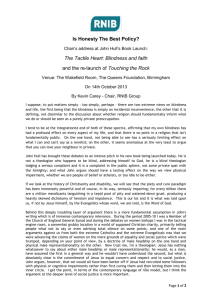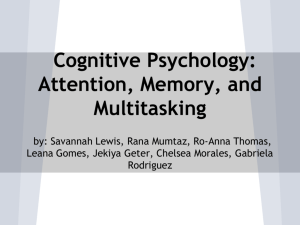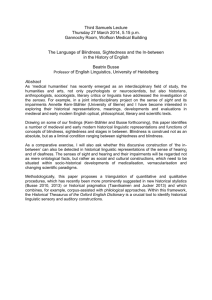Individual Differences in Choice Blindness
advertisement
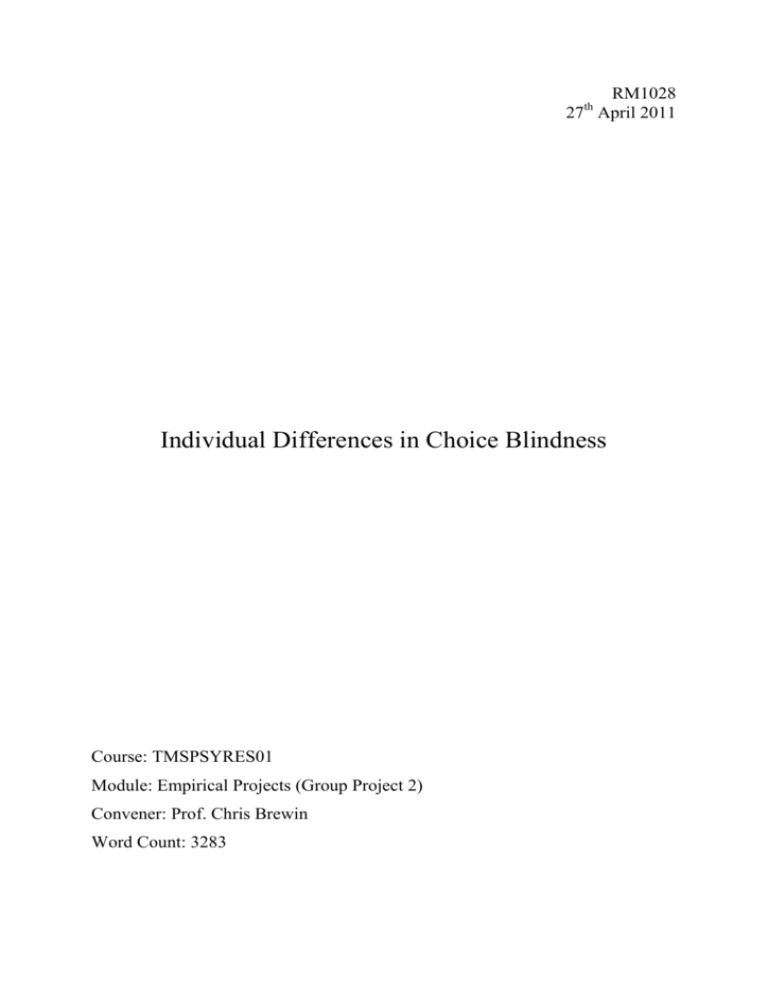
RM1028 27 April 2011 th Individual Differences in Choice Blindness Course: TMSPSYRES01 Module: Empirical Projects (Group Project 2) Convener: Prof. Chris Brewin Word Count: 3283 TABLE OF CONTENTS ............................................................................................................................ iv Abstract 1. Introduction ............................................................................................................................. 1 2. Method 2.1 2.2 2.3 3. Results 3.1 3.2 3.3 3.4 3.3 3.4 Participants......................................................................................................................4 Materials .........................................................................................................................4 Procedure ........................................................................................................................7 ............................................................................................................................. 8 CB Task ..........................................................................................................................8 Personality and CB .........................................................................................................8 AOSPAN and CB ......................................................................................................... 10 VWM and CB .............................................................................................................. 10 Socio demographics and CB ........................................................................................ 10 Predicting CB ................................................................................................................ 11 4. Discussion ........................................................................................................................... 12 References ........................................................................................................................... 14 Appendices Appendix A ...................................................... The abbreviated, 15-item Big Five questionnaire Appendix B ................................................................................................................. CB stimuli Appendix C ...................................................................................................... CB questionnaire ii ABSTRACT Inattentional, change and choice blindness are robust phenomena that can be experienced in different experimental situations. However, across all the studies, whereas a percentage of people are blind in these situations, other people can see. Introducing a new computerised task, we aim to explore whether there are individual differences associated with the CB phenomenon, in particular in conscientiousness, AOSPAN and VWM. There is a positive relationship between number of detections and conscientiousness, AOSPAN and educational level. However, no differences were found between the subjects experiencing CB and the ones that notice the manipulations. High WM capacity and conscientious individuals can be found in both groups. Taken together, this suggests that this capacity and personality trait are necessary for detection of the manipulations, but not sufficient to explain the CB phenomenon. Key words: choice blindness, conscientiousness, AOSPAN, VWM. iii 1. Introduction Our representation of the world is not as accurate and detailed as we usually believe. Our perceptual system generally processes what we are interested in or expecting (Kahneman, 1973), but fails to detect other events when our attention is focused on something else (Neisser, & Becklen, 1975). For instance, an experiment conducted by Simons and Chabris (1999), found that 66% of participants failed to notice a person wearing a gorilla costume move amongst basketball players when their attention was focused on monitoring the ball passes made by one of the teams. In a more experimentally controlled setting using computerised tasks (Most, Simons, Scholl, Jimenez, Clifford, & Chabris, 2001; Most, Scholl, Clifford, Simons, 2005), between 53% and 73% of the participants were not able to detect a stimulus that appeared across on the screen. This phenomenon has been called inattentional blindness (IB; Mack & Rock, 1998), and is defined as the failure to detect an unexpected or irrelevant stimulus in the visual field when engaged in a resource consuming task. During the 1990s a number of experiments studied the inability to detect changes to an object or scene from one view to the next when the change is accompanied by some other visual disturbance, a phenomenon named change blindness (Rensink, O´Regan, & Clark, 1997). For example, when two men´s faces were exchanged in a photograph, 50% of people failed to notice it (Grimes, 1996). People do not seem to detect changes that appear to be perfectly obvious if you know that they are going to happen. This phenomenon is even more surprising when it happens in real world situations: an experimenter asked a pedestrian for directions and was replaced by another experimenter after two confederates carried a door between them. 55% of the participants did not notice the change and simply continued with the conversation (Simons & Levin, 1998). Recently, a novel research tool has been introduced in which the design of change blindness is modified to incorporate a “decision” variable (Johansson, Hall, Sikström, & Olssom, 2005). The basic design of what has been called choice blindness (CB; Johansson, Hall, Sikström, 2008) consists of manipulating the outcome of participants´ choice in a decision setting. In Johansson et al. (2005) participants were asked to choose which face they found more attractive from two faces presented on cards. In three out of 15 trials, a double card ploy was used to covertly exchange the face they chose for the alternative face. Around 80% of the participants did not detect the change, even if they had to state verbally the 1 reasons of their choice once the manipulation was made. In a series of experiments about preferences of abstract patterns and faces, 75% and 80% of the participants, respectively, did not notice any of the manipulated trials (Joahnsson, Hall, Sikström, 2008). The CB paradigm has received a great deal of attention because it can be used to study other aspects of cognition; such as intention, decision making and introspection. Due to its applied relevance, the first aim of this study is to introduce a new computerised research tool for the study of CB. As discussed above, inattentional, change and choice blindness are robust phenomena that can be experienced in different experimental situations. However, across all the studies, whereas a percentage of people are blind in these situations, other people can see. Are some people impervious to this phenomenon as a result of their particular traits? Or did they just happen to be paying attention to a particular characteristic of the stimuli, noticing the manipulation as a result of random variability? Despite the multitude of empirical studies in inattentional and choice blindness, few studies have been conducted regarding individual differences in the experience of this phenomenon. It has been suggested that personality might have an effect in the experience of IB (Pappas, Fishel, Moss, Hicks, & Leek, 2005). In particular, it has been argued that people with high levels of conscientiousness might be less inattentionally blind. The reasoning behind this is not that conscientiousness itself would make them detect the unexpected event, but that it would make them more committed to the task and therefore more likely to notice the manipulations (Simons & Jensen, 2009). Nonetheless, there appears to be a lack of empirical evidence in this field, which makes it necessary to conduct new research. Regarding capacities, recent experiments have found evidence that executive functions, such as working memory (WM), predict IB, with individuals low in WM capacity (OSPAN/AOSPAN task) being more likely to be inattentionally blind (Richards, Hannon, & Derakshan, 2010). It should be noted that in that IB task participants are instructed to count the number of bounces of four white letters that move around the screen while ignoring four black letters that move in the background (Most et al., 2001). Around 50% of the participants did not notice a red plus sign crossing the screen during the task. On the other hand, no differences in processing styles (focal, global; Flicker task) or inhibition (Stroop task) were found between the inattentionally blind and not inattentionally blind groups. High WM 2 individuals are better at focusing their attention on the main task and ignoring irrelevant distractors (Conway & Engle, 1994), which leave them with more resources to process potentially salient stimuli. In the same line, Hannon and Richards (2010) reported the effect of WM (OSPAN task) in predicting IB, whereas no effect was found for visual working memory (VWM). These differences in two WM measures can be explained in terms of the demands of the tasks. In the VWM task there are no interference factors due to the small delay between presentation and test. Conversely, in the OSPAN/AOSPAN task the interference produced by the mathematical equations in longer-term data retrieval call on executive control functions, which can explain these differences in terms of the cognitive resources available. Nonetheless, the characteristics of the IB and CB tasks are not the same, and therefore other mechanisms could be behind the differences found in noticing the salient stimuli or change respectively. WM has been defined as the “temporary retention of information that was just experienced but no longer exists in the external environment” (D´Esposito, 2008). In the present CB task a small delay is introduced between the choice and the presentation of the outcome, when the participants have to indicate how certain they are of their choice. Since this delay is very small (only a few seconds), and considering the visual nature of the task, it can be argued that VWM could predict the performance in CB. On the other hand, the cognitive effort in asking the question can produce a significant interference, becoming an AOSPAN measure more predictive of CB. The second aim of this study is to explore whether there are individual differences associated with the CB phenomenon. In particular, in the light of previous theories and research, we hypothesise that high levels of conscientiousness, AOSPAN and VWM would have a preventative effect on experience of CB. 3 2. Method 2.1 Participants Sixty-five participants took part in the experiment in exchange for £5. All participants provided written informed consent before taking part in this study, which was approved by UCL’s institutional ethics committee. During the debriefing session, two participants reported to have detected for sure more than four changes, which indicates confabulation in their detection rate. The data for this two subjects and one more subject whose performance might have been affected due to not being familiarised with computers were removed from analysis. The remaining 62 participants had a mean age of 25.2 (range = 18-57, SD = 7.3; 40 women). 2.2 Materials - The abbreviated 15-item Big Five questionnaire (Furnham, McManus, & Scott, 2003). This pen-and-paper test is a quick measure of the five factors of personality, which includes 15 questions (see Appendix A) drawn from the sixty-item version of the questionnaire (NEOFFI; Costa and McCrae, 1997). The participants rate on a 5-point Likert-type scale (ranging from “strongly disagree” to “strongly agree”) how the presented statements describe them as a person. This test has shown adequate levels of validity and reliability. - Automated Operation Span (AOSPAN) task (Unsworth, Heitz, Schrock, & Engle, 2005). In this WM task programmed using E-Prime software, participants are required to memorise a series of letters from a total of 12 consonants, while solving simple mathematical equations (see Figure 1). After the practice trials, fifteen sets (three of each list length, from three to seven) are presented in a random order, producing a total of 75 letters. Participants do not know the list length until they are required to select with the mouse the correct words in the same order that they appeared. The AOSPAN index consists in the sum of the recalled words in the correct position, with a possible range of between 0 and 75. For the AOSPAN to be a valid measure of WM, a math accuracy criterion of 85% needs to be met (Turner and Engel, 1989; Unsworth et al., 2005). Only the data for people with 11 mathematical mistakes or less were analysed for this task. 4 Figure 1. Progression of the AOSPAN task. A. The participants are presented with a mathematical problem to be solved as quickly as possible. B. On the next screen, a possible answer is presented, and participants have to click on the correct box, “True” or “False”. C. A letter appears for latter recall. D. At the end of the set (which can contain 3, 4, 5, 6 or 7 trials), participants click in a 3x4 matrix of letters (F, H, J, K, L, N, P, Q, R, S, T, Y) the appropriate letters in the exact order they had appear. It should be noted that it is possible to leave a space blank when required. - Visual Working Memory (VWM) task (Hannon & Richards, 2010). This is a computerised adaptation from Luck and Vogel (1997) task using E-Prime software. The task consist in determine whether there are or not differences in the colour of one of the squares between the first and the second presentation (see Figure 2). Responses were collected by pressing the keys “4” for no change, (using the index finger of the left hand) or “7” for change (using the index finger of the right hand) of the keyboard. There is a total of 200 trials, 40 per condition of display, presented in a random order. Displays contain three, five, seven, nine or eleven squares. In each set size, 50% of the trials change the colour of one of the squares in the test arrays. Accuracy rates (Acc = hits – false alarms) and capacity rates (k = N x Acc, with N = number of elements in the display; Cowan, 2001) were both used as indexes of VWM. 5 Figure 2. Example of a 7 items display in the change condition. Sets of 40 x 40 pixels coloured squares (yellow, magenta, red, green, blue, white and black) are presented in the screen. Each trial is presented for 100 ms, and after a 900 ms interval the second test array is presented on the screen after the response is made. - Choice Blindness (CB) task. This computerised task, programmed in Matlab, is an adaptation of the methodology used in Johansson, Hall and Silkström (2008). The task consists in a simply binary choice of two pictures of female faces, roughly matched for similarity and attractiveness (see Figure 3). There was a total of 20 trials, 4 of which had a change manipulation. The presentation of the pairs of images was fixed across participants, and the manipulation always occurred on trial 6, 10, 15 and 19 (see Appendix B). During the task, the experimenters took notes about the behaviour of the subjects in the four manipulated trials, using one code per trial: NN = nothing noticed; FE = facial expression; M = movement; V = verbalisation. When the task was finished, all participants completed a questionnaire about the task (Appendix C), with a series of increasingly specific questions. In the questionnaire, they were told that they could have been assigned to one of two conditions with equal chance. If they selected Condition 1 (“control”), we conclude that they did not notice any of the manipulations. If they selected Condition 2 (“some trials manipulated”), they were asked to report separately how many changes they have detected for sure and how many just seemed odd, that is, trials in which they noticed that something strange happened but they cannot assure that it was a change in their choice. The CB index is the composite sum of the trials detected for sure, plus the trials in which something seemed odd weighted half: Composite = Sure + 0.5xOdd. Finally, all participants were debriefed. 6 Figure 3. Progression of a manipulated trial in the CB task. A. Each trial begins with the presentation of two images of the back side of playing cards. B. The two images turn, show the pictures of a pair of faces for 3 seconds, and then turn back again. C. Participants are asked to select with the mouse the back of the picture that they found more attractive. After each choice, participants rate in a 7-point scale how certain they are with their decision. D. Then the selected picture is shown again and they indicate in the same scale the attractiveness of the alternative they preferred. In this case, since it is a manipulated trial, the picture that reappears is the opposite that was selected. The size of the pictures is 442 x 548 pixels. 2.3 Procedure Each session took approximately 45 minutes. The personality test and the OSPAN were counterbalanced across participants with the CB task always presented third and the VWM last to prevent the performance of participants being affected. For the computerised tasks 15 inches laptops were used with a screen configuration of 1024 x 768 pixels. 7 3. Results Thirty-three of the participants (53%) were choice blind (CB) as they reported not having noticed any of the manipulations even after being told about the possibility of them. The remaining twenty-nine participants reported having noticed at least one change, so were categorised as not choice blind (NCB; see Table 1). It should be noted that the total in the second column is smaller than the total of people in the NCB group. This was because not everyone reported trials in which something seemed odd. Table 1. Frequency distribution of the number of pairs detected for sure and pairs in which something seemed odd. The distribution of the Composite (Sure + 0.5xOdd) is presented in the third column. N Total For sure N Sth. odd N 1 2 3 4 7 16 4 2 1 2 3 4 3 6 1 1 29 11 Composite 1 2 2.5 3 4 N 6 9 3 9 2 29 CB task According to the participants´ reports in the variable for sure of the questionnaire, 24% of the manipulated trials were detected. In the experimenters´ observational report, the first manipulated pair was detected (FE, M or V) 15% of the time, the second 26%, the third 32% and the forth 23%; which, tallying the previous source, makes an average of 24% of detections for the manipulated trials. The reaction time for the attractiveness rating (the question that appeared following the manipulation) of the manipulated trials was significantly slower for the NCB participants (t60 = -4.301, p =.000). Personality and CB An independent t-test on personality comparing CB and NCB groups was performed. No significant mean differences in any of the five factors of personality were found (see table 2). 8 Table 2. Personality independent t-test Trait t Sig. N .418 .677 E .058 .954 O .817 .417 A .951 .345 C -.712 .479 Group (N) CB (33) NCB (29) CB (33) NCB (29) CB (33) NCB (29) CB (33) NCB (29) CB (33) NCB (29) Mean (SD) 8.18 (.40) 7.93 (.45) 11.03 (.32) 11.00 (.41) 10.72 (.40) 10.24 (.44) 12.42 (.35) 11.93 (.38) 10.24 (.50) 10.72 (.46) In order to control for manipulations that might have been detected by a coincidence (for instance a face that looks like a relative), we performed a series of new analysis. Firstly, we compared the people with high detection rate (Composite > 2) with the choice blind. Secondly, we will compare the participants within the NCB group, with high (Composite > 2) and low detection rate (Composite ≤ 2). Participants with low detection rates still experience CB in at least half of the trials, and it is interesting to study them as a group. A significant between-group difference was found for Conscientiousness in both analyses (Table 3). No other significant results were found for the rest of the personality traits. Table 3. Conscientiousness independent t-test Comparison Trait t p CB – HighNCB C -2.087 .044 LowNCB – HighNCB C -2.448 .021 Group (N) CB (33) High (14) Low (15) High (14) Mean (SD) 10.24 (2.86) 11.78 (2.04) 9.73 (2.46) 11.78 (2.04) The ordinal nature of the variable Composite allows us to correlate it with other variables. It should be noted that in this variable the CB subjects were not included. Even though it could be argued that their performance should be interpreted as 0, in fact it represents something qualitative and categorically different, that is, being choice blind. The results of the second t-test indicates a possible correlation between C and the Composite. Although non-significant (r = .297, n = 29, p = .118), this correlation presents a medium effect size (small, r = .10; medium, r = .30; large, r = .50; Cohen, 1992). 9 AOSPAN and CB In this section, only the data of participants that meet the 85% mathematical accuracy criterion was analysed (46 subjects). This means a total of 16 subjects, 11 CB (18%) and 5 NCB (8%) were excluded from analysis. No significant results (see Table 4) were found in any of the three types of analysis discussed above. Nevertheless, the difference between means in the Low-High comparison is quite large in absolute terms. In fact, Cohen´s effect size for this independent t-test is d = 0.71 (Faul, Erdfelder, Buchner, & Lang, 2009).This can be considered as a medium-large effect (small, d = .20; medium, d = .50; large, d = .80; Cohen, 1992). Table 4. Independent t-test for the AOSPAN measure Comparison t p CB – NCB 1.222 .228 CB – HighNCB .063 .950 LowNCB – HighNCB -1.678 .108 Group (N) CB (22) NCB (24) CB (22) High (12) Low (12) High (12) Mean (SD) 43.14 (15.87) 37.29(16.55) 43.14 (15.87) 42.75 (17.62) 31.83 (14.05) 42.75 (17.62) No significant correlation was found between the AOSPAN measure and Composite (r = .360, n = 24, p = .084). Nonetheless, this correlation represents a medium-large effect size. VWM and CB None of the VWM indexes (Acc and k) showed mean differences in either of the comparisons. That was true for the five set sizes and the total scores created. Sociodemographics and CB A one-way ANOVA was performed to explore the effect of age. No significant results were found. A mean comparison of age showed no differences. Nevertheless, significance for two t-tests of educational level (EL) was found (Table 5). The correlation between EL and Composite was r = .476 (n = 29, p = .009). 10 Independent t-test for educational level. Educational levels were coded hierarchically: 1 = Secondary school, 2 = GCSEs, 3 = A-levels, 4 = Vocational training, 5 = Undergraduate studies, 6 = Postgraduate studies. Table 5. Comparison t p CB – NCB -.465 .644 CB – HighNCB -3.834 .000 LowNCB – HighNCB -3.577 .002 Group (N) CB (33) NCB (29) CB (33) High (14) Low (15) High (14) Mean (SD) 4.52(1.37) 4.69 (1.56) 4.52 (1.37) 5.57 (0.51) 3.87 (1.77) 5.57 (0.51) Predicting CB Considering the results obtained, four regression models using the “enter” method were performed for predicting the variable Composite (see Table 6). All models were significant, however, as expected due to the p value of the previous correlations, only the variable EL was individually significant. The correlation matrix can be found in Table 7. Table 6. Regression analysis for predicting Composite Model 1 N 29 Variable EL β .476 t 2.815 p .009 F p 7.924 .009 R2 .227 AR2 .198 2 29 EL C .465 .278 2.837 1.694 .009 .102 5.672 .009 .304 .250 EL AOSPAN .506 .295 2.923 1706 .008 .103 6.473 .006 .381 .322 EL C .485 .114 2.728 .645 .013 .526 AOSPAN .291 1.654 .114 4.334 017 .394 .303 3 4 24 24 Table 7. Correlation matrix and (p) levels Measures Composite EL C AOSPAN Composite (.009) (.118) (.084) N EL .476 (.829) (.550) C .297 .042 (.771) AOSPAN .360 .128 .063 - 29 29 24 11 4. Discussion The primary first aim of this study was to test a new CB task. During the original card- based magic trick experiments, the possibility of a change in the outcome of the choice would be unlikely to be contemplated in the first place. However, in a computerised task the participants are aware that any kind of manipulation is posible. The results indicate that more than half of the participants were choice blind, and only a small proportion of manipulations were detected, in a similar percentage to previous studies (Hall, & Johansson, 2008). These results support the choice blindness phenomenon, that it even extends computer-based situations. The use of a computerised task presents a more experimentally controlled setting, with no possible interference due to the experimenter. Moreover, the performance of the subject is fully recorded, providing information that could not be obtained with traditional methods, such as reaction times. The secondary aim of this study was to explore possible individual differences that could explain why some people and not others are choice blind. We hypothesised that low levels of conscientiousness would predict being CB. Although no differences were found for CB-NCB groups, the high detection group scored significantly higher that the low detection or CB groups. One possible explanation, as argued before, is that high conscientious people would be more engaged. In previous experiments, manipulating the level of involvement in the task (i.e. giving reports, rating the pictures) has proved to reduce the possibility to experience CB. This task in particular consists in making a decision, and therefore conscientious people (who tend to be deliberative and to think carefully before acting) would be more involved in their choice, and less likely to not notice the manipulations. Regarding WM, the results are in the same directions as previous studies. The AOSPAN scores do not differ for any of the comparisons. However, although not significant, there was a considerable large difference between high and low detection groups. On the other hand, no effect of VWM was found. It was expected that those individuals who noticed the changes would have high WM and conscientiousness, while those who did not notice would have low levels. However, there were a number of individuals with high WM resources and high levels of conscientiousness that did not notice any of the changes. This suggest that this capacity and personality trait are 12 necessary for detection of the manipulations, but not sufficient to explain the CB phenomenon. The IB studies are generally based on a single-trial test. However, in our task we use with an ordinal variable with four levels, which allows us to have a richer measure of CB. Surprisingly, an unpredicted variable, level of education, played an important role in the explanation of level of detection (Composite), accounting for 20% of its variance (model 1). Moreover, including AOSPAN in the equation, the predictive power increases to 32% (model 3). Due to the underpowered size sample this increment is not statistically significant. However, this is an exploratory study of individual differences in CB without precedents, therefore a sample size of 65 subjects can be considered adequate. Here we are illustrating the preliminary results; further studies with larger samples are required to confirm these findings. The research in this field has almost entirely com from the visual cognition sciences. Interestingly, some of the first studies about inattention regarded auditory perception (Kahneman, 1973). For example, Neiser (1967) carried out an experiment in which two spoken messages were listened simultaneously. The participants were able to follow one of them, but could report very little or nothing about the other. Recently, a consumer choice study showed evidence of choice blindness for the sense of smell and taste (Hall, Johansson, Täring, Sikström, Deutgen, 2010). In particular, for the taste of jams as different as ginger and lime, and for teas such as sweet mango and liquorice pernod. We are talking about blindness but perhaps we should be talking about a general perceptual condition. Further research exploring the commonalities of this phenomenon across sensory modalities might be required to fully understand the mechanisms behind inattentional, change and choice blindness. In particular, the choice blindness paradigm allows the study of non-perceptual psychological phenomena such as opinions, values, and attitudes. Future research could focus on determining whether the characteristics of people who experience choice blindness for visual tasks are the same as for those who experience if for e.g. a questionnaire about opinions. 13 REFERENCES Cohen, J (1992). A power primer. Psychological Bulletin, 112, 155–159. Conway, A. R. A., & Engle, R. W. (1994). Working memory and retrieval: a resourcedependent inhibition model. Journal of Experimental Psychology: General, 123, 354373. Costa Jr, P.T., y McCrae, R.R. (1997). Personality traits structure as a human universal. American Psychologist. 52 (5), 509-516. Cowan, N. (2001). The magical number four in short term memory: A reconsideration of mental storage capacity. Behavioural & Brain Sciences. 41, 87-114. D´Esposito, M. (2008). From cognitive to neural models of working memory. In Mental processes in the human brain. Driver, J., Haggard, P., Shallice, T. (eds.). Oxford, Oxford University Press. Faul, F., Erdfelder, E., Buchner, A., & Lang, A.-G. (2009). Statistical power analyses using G*Power 3.1: Tests for correlation and regression analyses. Behavior Research Methods, 41, 1149-1160. Furnham, A., McManus, I. C., & Scott, D. (2003). Personality, empathy and attitudes to animal welfare, Anthrozoös, 16, 135-146. Grimes, J. (1996). On the failure to detect changes in scenes across saccades. In Perception, Vancouver Studies in Cognitive Sciences, Vol.2. Oxford University Press. Hall, L., Johansson, P., Täring, B., Sikström, S., Deutgen, T. (2010). Magic at the marketplace: Choice blindness for the taste of jam and the smell of tea. Cognition, 117, 54-61. Hannon, E. M., Richards, A., (2010). Is inattentional blindness related to individual differences in visual working memory capacity or executive functioning? Perception. Doi: 10.1068/p.6379. Johansson, P., Hall, L., Sikström, S., & Olsson, A. (2005). Failure to Detect Mismatches Between Intention and Outcome in a Simple Decision Task. Science, 310, 116-119. Johansson, P., Hall, L., & Sikström, S. (2008). From change blindness to choice blindness. Psychologia, 51, 142-155. Kahneman, D. (1973). Attention and effort. Englewood Cliffs, NJ: Prentice Hall. Luck, S. J., & Vogel, E. K. (1997). The capacity of visual working memory for features and conjunctions. Nature, 390, 279-281. Mack, A., & Rock, I. (1998). Inattentional blindness. Cambridge, MA: MIT Press. 14 Most, S. B., Scholl, B. J., Clifford, E. R., Simons, D. J. (2005). What you see is what you set: Sustained Inattentional Blindness and the capture of awareness. Psychological Review, 112, 217-242. Most, S. B., Simons, D. J., Scholl, B. J., Jimenez, R., Clifford, E., & Chabris, C. F. (2001). How not to be seen: The contribution of similarity and selective ignoring to sustained inattentional blindness. Psychological Science, 12, 9-17. Neisser, U. (1967). Cognitive psychology. New York: Appleton-Century-Crofts. Neisser, U., & Becklen, R., (1975). Selective looking: attending to visually specified events. Cognitive Psychology, 7, 480-494. Pappas, J. R., Fishel, S. R., Moss, J. D., Hicks, J. M., & Leek, T. D., (2005). An eye traking approach to inattentional blindness. Perception and Performance, 5, 1658-1662. Rensink, R. A., O´Regan, J. K., & Clark, J. J. (1997). To See or Not to See: The Need for Attention to Perceive Changes in Scenes. Psychological Science, 8, 368-373. Richards, A., Hannon, E. M., Derakshan, N. (2010). Why are some People Inattentionally Blind and can Training reduce its frequency of occurrence? Psychological Research. doi: 10.1007/s00426-009-0273-8. Simons, D. J. (1996). In sight, out of mind: When object representations fail. 7, 301-307. Simons, D. J., & Chabris, C. F. (1999). Gorillas in our midst: Sustained inattentional blindness for dynamic events. Perception, 28, 1059-1074. Simons, D. J. & Jensen, M. S. (2009). The effects of individual differences and task difficulty on inattentional blindness. Psychonomic Bulletin & Review, 16 (2), 398-403. Simond, D. J., & Levin, D. T. (1998). Failure to detect changes to people during a real-world interaction. Psychonomic Bulleting & Review, 5 (4), 644-649. Turner, M. L., & Engel, R. W. (1989). Is working memory capacity task dependent? Journal of Memory and Language, 28, 127-154 Unsworth, N., Heitz, R. P., Schrock, J. F., & Engle R. W. (2005). An automated version of the operation span. Behaviour Research Methods, 37 (3), 498-505. 15 APPENDIX A. The abbreviated, 15-item Big Five questionnaire. Note: Items 10, 11 and 13 are reverse scored. Neuroticism = p3 + p6 + p9. Extraversion = p5 + p7 + p8. Openness = p4+ rp11 + p14. Agreeableness = p1 + rp10 + p12. Conscientiousness = p2 + rp13 + p15. Do you agree with the way these statements describe you as a person? Please tick the correct box. Strongly Disagree Disagree Neutral Agree Strongly agree 1.I try to be courteous to everyone I meet 2. I'm pretty good about pacing myself so as to get things done on time 3. When I'm under a great deal of stress, sometimes I feel like I'm going to pieces 4. I am intrigued by the patterns I find in art and nature 5. I really enjoy talking to people 6. I often feel tense and jittery 7. I like to be where the action is 8. I often feel as if I'm bursting with energy 9. I often get angry at the way people treat me 10. Some people think of me as cold and calculating 11. I have little interest in speculating on the nature of the universe or the human condition 12. I generally try to be thoughtful and considerate 13. I never seem to be able to get organised 14. I often enjoy playing with theories or abstract ideas 15. I strive for excellence in everything I do A APPENDIX 2. CB stimuli. The manipulations took place in the trials 6, 10, 15 and 19. Pair 1 Pair 2 Pair 3 Pair 4 Pair 5 Pair 6 Pair 7 Pair 8 Pair 9 Pair 10 Pair 11 Pair 12 Pair 13 Pair 14 Pair 15 Pair 16 Pair 17 Pair 18 Pair 19 Pair 20 B APPENDIX 3. CB questionnaire. Participant Number: _____ Age: _____ Gender: _____ Educational level: o Secondary school o Vocational training o GCSEs o Undergraduate studies o A-levels o Postgraduate studies If you have any comments about what could be improved in the task you just did, please write them down here: Have you noticed any problems in the task? (Please circle) o Yes o No If you answered yes, of what nature were the problems? How often did they occur? In this test, you could have been assigned to one of two conditions with equal chance. In condition 1 the face that reappeared on the screen after you made your choice was always the one that you have picked as the more attractive. In condition 2, in a few trials, the face that reappeared was not the one that you originally picked as the more attractive. Which condition were you in? o Condition 1 o Condition 2 If you were in Condition 2, on how many trials did you notice this change? (Please count the times when you noticed for sure and when something just seemed odd, separately) o Noticed for sure: o Something seemed odd: We would be very grateful if you wouldn’t talk about it to anyone. Thank you for your participation in this task. C

